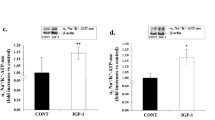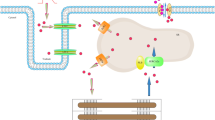Abstract
Aging process is accompanied by various biological dysfunctions including altered calcium homeostasis. Modified calcium handling might be responsible for changed cardiac function and potential development of the pathological state. In the present study we compared the mRNA and protein levels of the intracellular Ca2+-handling proteins—inositol 1,4,5-trisphosphate receptor (IP3R), ryanodine receptor (RyR), sarcoplasmic reticulum Ca2+ pump (SERCA2), and also transient receptor potential C (TRPC) channels in cardiac tissues of 5-, 15-, and 26-month-old rats. Aging was accompanied by significant increase in the mRNA levels of IP3R and TRPC channels in both ventricles and atria, but mRNA level of the type 2 RyR was unchanged. Protein content of the IP3R1 correlated with mRNA levels, in the left ventricle of 15- and 26-month-old rats the value was approximately 1.8 and 2.8-times higher compared to 5-month-old rats. No significant differences were observed in mRNA and protein levels of the SERCA2 among 5-month-old and aged rats. However, Ca2+-ATPase activity significantly decreased with age, activities in 5-, 15-, and 26-month-old rats were 421.2 ± 13.7, 335.5 ± 18.1 and 304.6 ± 14.8 nmol Pi min-1 mg−1. These results suggest that altered transporting activity and/or gene expression of Ca2+-handling proteins of intracellular Ca2+ stores might affect cardiac function during aging.


Similar content being viewed by others
References
Slavikova J, Dvorakova M, Reischig J, Palkovits M, Ondrias K, Tarabova B, Lacinova L, Kvetnansky R, Marks A, Krizanova O (2006) IP3 type 1 receptors in the heart: their predominance in atrial walls with ganglion cells. Life Sci 78:1598–1602
Sorrentino V, Volpe P (1993) Ryanodine receptors: how many, where and why? Trends Pharmacol Sci 14:98–103
Giannini G, Conti A, Mammarella S, Scrobogna M, Sorrentino V (1995) The ryanodine receptor/calcium channel genes are widely and differentially expressed in murine brain and peripheral tissues. J Cell Biol 128:893–904
MacKrill JJ (1999) Protein-protein interactions in intracellular Ca2+-release channel function. Biochem J 337(Pt 3):345–361
Minke B (2006) TRP channels and Ca2+ signaling. Cell Calcium 40:261–275
Vennekens R, Voets T, Bindels RJ, Droogmans G, Nilius B (2002) Current understanding of mammalian TRP homologues. Cell Calcium 31:253–264
Narayanan N (1987) Comparison of ATP-dependent calcium transport and calcium-activated ATPase activities of cardiac sarcoplasmic reticulum and sarcolemma from rats of various ages. Mech Ageing Dev 38:127–143
Bers DM (2002) Sarcoplasmic reticulum Ca release in intact ventricular myocytes. Front Biosci 7:d1697–1711
Igwe OJ, Filla MB (1997) Aging-related regulation of myo-inositol 1,4,5-trisphosphate signal transduction pathway in the rat striatum. Brain Res Mol Brain Res 46:39–53
Xu A, Narayanan N (1998) Effects of aging on sarcoplasmic reticulum Ca2+-cycling proteins and their phosphorylation in rat myocardium. Am J Physiol 275:H2087–2094
Cain BS, Meldrum DR, Joo KS, Wang JF, Meng X, Cleveland JC Jr, Banerjee A, Harken AH (1998) Human SERCA2a levels correlate inversely with age in senescent human myocardium. J Am Coll Cardiol 32:458–467
Lim CC, Liao R, Varma N, Apstein CS (1999) Impaired lusitropy-frequency in the aging mouse: role of Ca(2+)-handling proteins and effects of isoproterenol. Am J Physiol 277:H2083–2090
Lakatta EG, Sollott SJ (2002) The “heartbreak” of older age. Mol Interv 2:431–446
Genazzani AA, Carafoli E, Guerini D (1999) Calcineurin controls inositol 1,4,5-trisphosphate type 1 receptor expression in neurons. Proc Natl Acad Sci U S A 96:5797–5801
Seth M, Sumbilla C, Mullen SP, Lewis D, Klein MG, Hussain A, Soboloff J, Gill DL, Inesi G (2004) Sarco(endo)plasmic reticulum Ca2+ ATPase (SERCA) gene silencing and remodeling of the Ca2+ signaling mechanism in cardiac myocytes. Proc Natl Acad Sci U S A 101:16683–16688
Riccio A, Medhurst AD, Mattei C, Kelsell RE, Calver AR, Randall AD, Benham CD, Pangalos MN (2002) mRNA distribution analysis of human TRPC family in CNS and peripheral tissues. Brain Res Mol Brain Res 109:95–104
Terada Y, Tomita K, Nonoguchi H, Marumo F (1993) PCR localization of angiotensin II receptor and angiotensinogen mRNAs in rat kidney. Kidney Int 43:1251–1259
Lowry OH, Rosebrough NJ, Farr AL, Randall RJ (1951) Protein measurement with the Folin phenol reagent. J Biol Chem 193:265–275
Zacikova L, Kvetnansky R, Krizanova O (1999) Increased expression of the Na(+)/Ca(2+) exchanger in the rat heart after immobilization stress is not induced by cortisol. FEBS Lett 457:423–428
Kaplan P, Babusikova E, Lehotsky J, Dobrota D (2003) Free radical-induced protein modification and inhibition of Ca2+-ATPase of cardiac sarcoplasmic reticulum. Mol Cell Biochem 248:41–47
Zhu X, Altschafl BA, Hajjar RJ, Valdivia HH, Schmidt U (2005) Altered Ca2+ sparks and gating properties of ryanodine receptors in aging cardiomyocytes. Cell Calcium 37:583–591
Li PP, Vecil GG, Green MA, Warsh JJ (1992) Inositol 1,4,5-trisphosphate receptor in developing and senescent rat cerebellum. Neurobiol Aging 13:89–92
Martini A, Battaini F, Govoni S, Volpe P (1994) Inositol 1,4,5-trisphosphate receptor and ryanodine receptor in the aging brain of Wistar rats. Neurobiol Aging 15:203–206
Igwe OJ, Ning L (1993) Inositol 1,4,5-trisphosphate arm of the phosphatidylinositide signal transduction pathway in the rat cerebellum during aging. Neurosci Lett 164:167–170
Sugawa M (1993) Alterations of inositol phosphate turnover in striatum of aged rats. Eur J Pharmacol 247:39–44
Lompre AM, Lambert F, Lakatta EG, Schwartz K (1991) Expression of sarcoplasmic reticulum Ca(2+)-ATPase and calsequestrin genes in rat heart during ontogenic development and aging. Circ Res 69:1380–1388
Takahashi Y, Yoshida T, Takashima S (1992) The regulation of intracellular calcium ion and pH in young and old fibroblast cells (WI-38). J Gerontol 47:B65–70
Knyushko TV, Sharov VS, Williams TD, Schoneich C, Bigelow DJ (2005) 3-Nitrotyrosine modification of SERCA2a in the aging heart: a distinct signature of the cellular redox environment. Biochemistry 44:13071–13081
Van Gelder IC, Brundel BJ, Henning RH, Tuinenburg AE, Tieleman RG, Deelman L, Grandjean JG, De Kam PJ, Van Gilst WH, Crijns HJ (1999) Alterations in gene expression of proteins involved in the calcium handling in patients with atrial fibrillation. J Cardiovasc Electrophysiol 10:552–560
Pepe S, Tsuchiya N, Lakatta EG, Hansford RG (1999) PUFA and aging modulate cardiac mitochondrial membrane lipid composition and Ca2+ activation of PDH. Am J Physiol 276:H149–158
Lucas DT, Szweda LI (1998) Cardiac reperfusion injury: aging, lipid peroxidation, and mitochondrial dysfunction. Proc Natl Acad Sci U S A 95:510–514
Hajnoczky G, Csordas G, Madesh M, Pacher P (2000) The machinery of local Ca2+ signalling between sarco-endoplasmic reticulum and mitochondria. J Physiol 529(Pt 1):69–81
Lin X, Varnai P, Csordas G, Balla A, Nagai T, Miyawaki A, Balla T, Hajnoczky G (2005) Control of calcium signal propagation to the mitochondria by inositol 1,4,5-trisphosphate-binding proteins. J Biol Chem 280:12820–12832
Kourie JI (1998) Interaction of reactive oxygen species with ion transport mechanisms. Am J Physiol 275:C1–24
Acknowledgment
This work was supported by VEGA 1/2263/05, 2/6078, 2/5125, APVT–51-027404, and Genomika SP 51/0280800/0280802.
Author information
Authors and Affiliations
Corresponding author
Rights and permissions
About this article
Cite this article
Kaplan, P., Jurkovicova, D., Babusikova, E. et al. Effect of aging on the expression of intracellular Ca2+ transport proteins in a rat heart. Mol Cell Biochem 301, 219–226 (2007). https://doi.org/10.1007/s11010-007-9414-9
Received:
Accepted:
Published:
Issue Date:
DOI: https://doi.org/10.1007/s11010-007-9414-9




